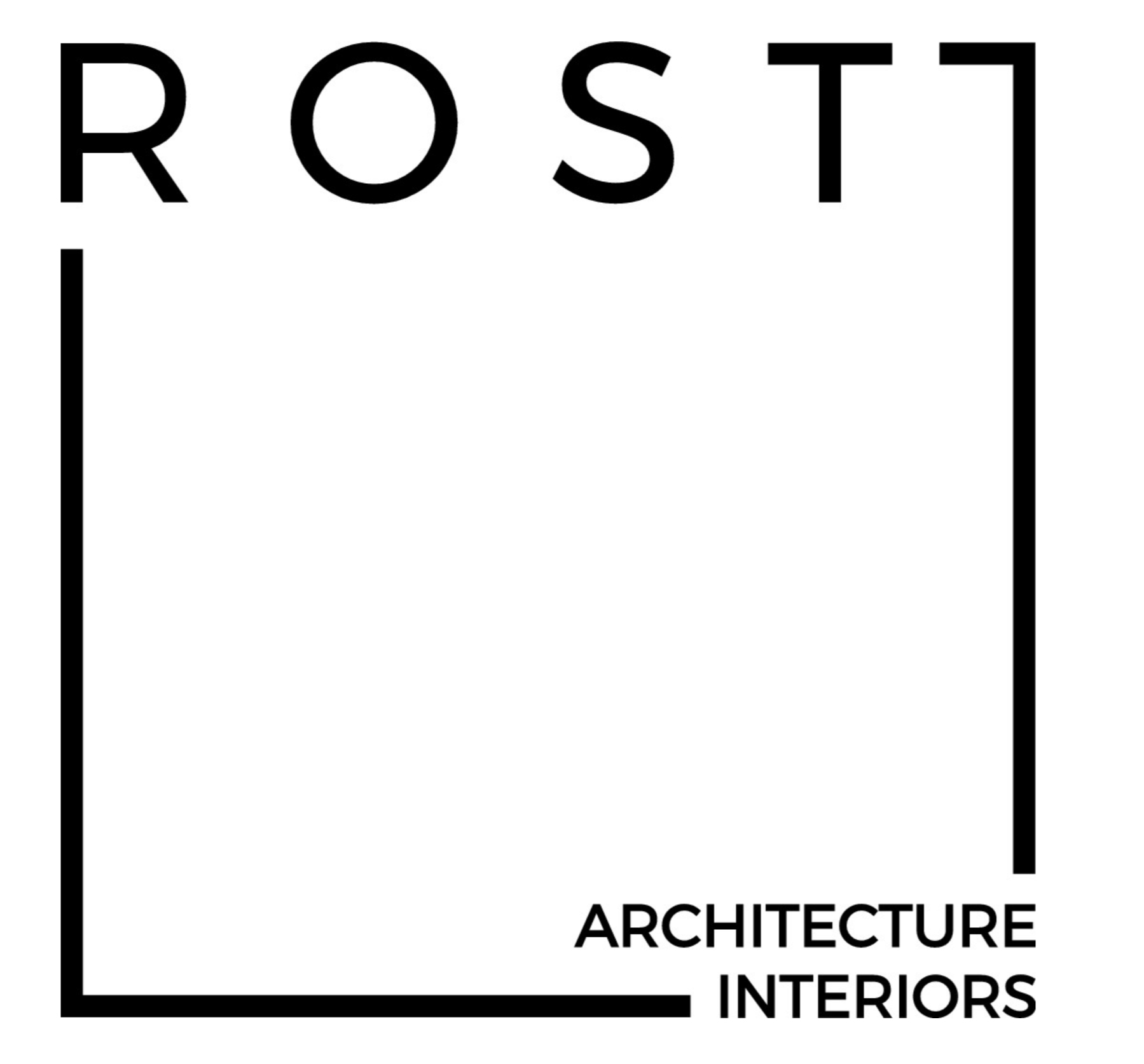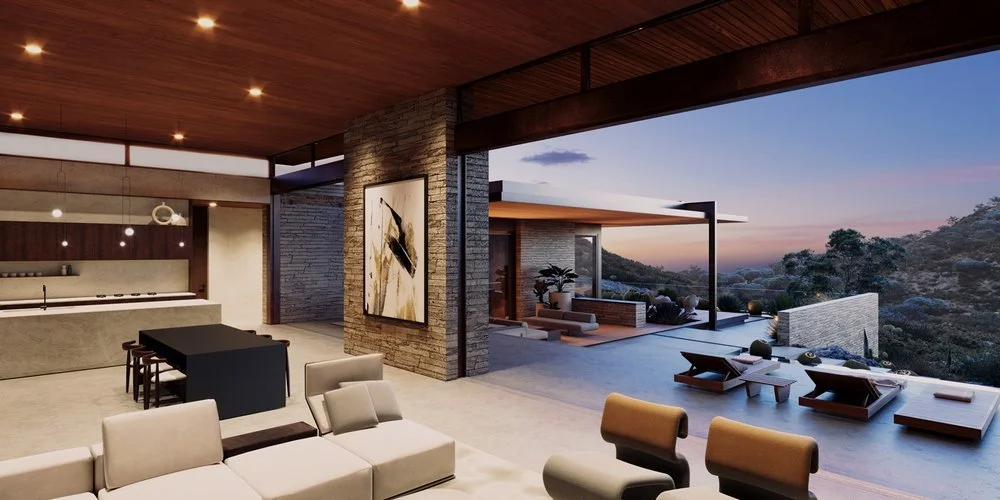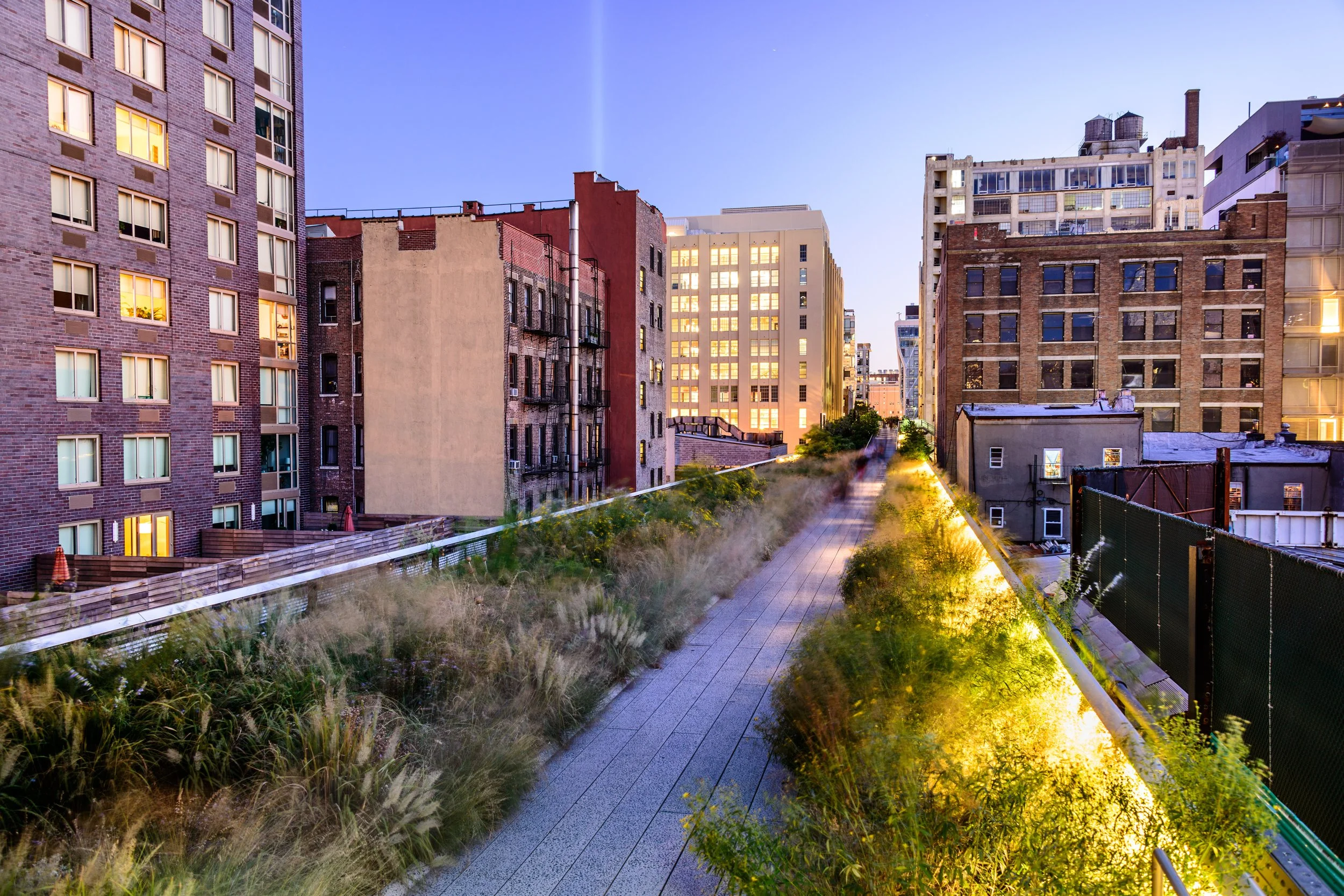The Story Behind The High Line, New York City’s “Park in the Sky”
The High Line in New York City is an iconic example of urban revitalization, transforming an abandoned industrial rail line into a vibrant landscaped public park. This elevated garden stretches from Gansevoort Street to 34th Street and has become a cultural and recreational hub. The High Line's story is one of evolution, from its origins as a bustling freight rail line to its decline and eventual rebirth as a symbol of innovative landscape urban design.
Experiencing the High Line was thought-provoking and energizing. It made me feel optimistic about the future of cities. It showed awareness and effort to re-integrate nature into our cities. I visited the park over several days in early October; the weather was cool and crisp, and the leaves around the city were beginning to turn orange. The High Line gave me the unique experience of being within the city while feeling protected and at peace in nature.
Walking on the High Line was a strange but pleasant sensation, and it was very different from my previous visits to New York, where I only engaged with the city from the streets and sidewalks at ground level. These visits seemed immersive and thrilling, but the chaos of dodging pedestrians and cars compromised and distracted me from the opportunity to absorb my surroundings fully. The experience of the High Line relieved me of that chaos and gave me the space and perspective to absorb more of the city from a different vantage point above the chaos.
I was impressed by the High Line, from the experience it offered to the history and design of the structure. From nearly every angle, I sensed that great care and skill went into its creation. If you plan to visit the High Line, I urge you to learn more about its history, design, chronology, and the events that led to its conception. Its story and genesis are just as beautiful as the experience of walking along its gardens.
Photograph of the Highline. Photograph Copyright by Mitchell Rocheleau 2024
The High Line's Industrial Roots
The High Line was originally constructed as part of the West Side Improvement project, one of New York City's most ambitious infrastructure undertakings. Completed in the early 1930s, amid the Great Depression, this project aimed to elevate the railway above street level to improve safety and transportation efficiency. The original train line ran on the ground level. Because the line ran between buildings, it was difficult for pedestrians to see trains coming, and this resulted in many deaths on 10th Avenue. The rail company decided something needed to be done, so they built an elevated rail line along the same path.
The labor for the project was mobilized from the Works Progress Administration, part of the stimulus programs from Franklin D. Roosevelt's New Deal. The High Line stretched 13 miles along Manhattan's West Side, connecting factories, warehouses, and distribution centers.
In its heyday, the original rail line played a crucial role in the city's industrial economy. Trains transported meat, dairy, produce, and other goods to the buildings along its path. It facilitated seamless cargo loading and unloading, helping fuel industries' growth in the Meatpacking District, Chelsea, and beyond.
The High Line exemplifies authenticity. The original railway was embedded in the city for decades, part of New Yorkers' experience. They were familiar with it and identified with it. It was part of their identity. Preserving the structure preserved that identity, keeping it intact and authentic.
The High Line's Abandonment
However, the High Line's prominence began to wane in the 1950s and 60s with the rise of interstate trucking and changes in the food industry. These shifts led to declining rail freight traffic, rendering the High Line slowly obsolete. By the 1980s, the once-thriving railway had fallen into disuse, and sections were dismantled or overgrown with vegetation.
Proposals to demolish the structure began to circulate. But amid the decay, a spark of hope emerged—a vision to transform the derelict railway into something new and meaningful.
The High Line's Rebirth
In 1999, two neighborhood residents, Joshua David and Robert Hammond, founded the Friends of the High Line, a community-based non-profit organization with a mission to preserve and repurpose the railway. Their vision was to transform the High Line into a linear public park serving the community and honoring the city's industrial heritage. The visions stemmed from photographs of the self-sown plant growth that began germinating on the old railway.
In many ways, the idea of the High Line came from Mother Nature. Photos of the High Line taken in the 1990s showed nature reclaiming the structure; the design team's goal was to recapture the essence of those photographs and make it accessible to the public.
Joel Sternfeld's most iconic shot of the High Line, looking east along 30th St. A railroad artifact, May 2001.
Photo by Joel Sternfeld
The turning point came in 2003, when a design competition attracted innovative proposals worldwide. The team of Diller Scofidio + Renfro and James Corner Field Operations was selected to lead the redevelopment. Their winning design envisioned a dynamic public space blending the existing urban relic and nature.
The design of the High Line is an interplay between path and nature. Concrete planks line the paths, which gently dissolve and taper into the natural vegetation. Piet Oudolf, the project's leading plant designer, selected perennial hardy species that sustain themselves year-round. The planting mimics a natural meadow, appearing relatively unstructured and playful.
Details of the High Line
There are many incredibly thoughtful and clever details of the High Line. My favorite is the design language used to transition from the garden to the walking paths. As mentioned above, the paver pattern is designed to dissolve into the landscape. This transition eliminates abrupt edges between the path and the garden.
The designers chose to re-introduce elements of the original railway into the design playfully. Old train tracks have been preserved as landscape elements, along with sun deck chairs that slide on old rail tracks, reminding users of the structure’s original use. These thoughtful nods honor the High Line’s history and provide clues to its original use.
Construction Chronology of the High Line
The transformation of the High Line into a public park was a multi-phased project that began with the opening of the first section, from Gansevoort Street to 20th Street, in 2009. This initial phase introduced visitors to a lush green space with pathways, seating areas, and native plantings. It quickly became a popular destination for both locals and tourists.
Subsequent sections were opened in the following years, extending the park's reach and adding new features. The final section, reaching 34th Street, was completed in 2014. Each segment of the High Line was thoughtfully designed to reflect the character of its surroundings while offering diverse experiences, from serene gardens to vibrant gathering spaces.
Experiencing the High Line
The High Line is always evolving because of the nature of landscape and plant medium. Visitors can never experience the same High Line twice; it always evolves according to the seasons, daily climates, times, and weather. It is imperfect and doesn’t attempt to be perfect like a static work of architecture might, which is constantly resisting the effects of Mother Nature. Its gardens accept the seasons and reflect them.
The High Line elevates visitors roughly three stories above the ground, a unique and unusual way to experience the city. Many have described the sensation as a “park in the sky.” At this level, visitors can move through the city for nearly 22 blocks.
Visitors to the High Line become performers on a stage. They walk down the promenade, on display to those peering down from the surrounding buildings. In this sense, the High Line makes the user feel special. The visitor plays the leading role in an urban theater in many ways.
The High Line is also a viewing apparatus for observing the city. It facilitates a slower, removed and less intense city experience relative to the sidewalks below. It is a place where you can observe the city below and be in the city but simultaneously feel removed, protected, and within. This starkly contrasts its original industrial intent to increase speed and efficiency.
The High Line proposes a response or alternative way of life for New Yorkers. The typical daily life is fast paced, rushed, and hustled, which greatly contrasts with the rest of New York. With recent trends in minimalism, slower living, and more contemplative intentional daily rhythms, the High Line fits right in. The High Line interrupts and challenges the norm of New York.
Two Personalities of the High Line
The High Line has a strange but charismatic split personality as an aged relic of post-industrial America and a thriving natural garden. The first personality is that of the iconic industrial city with its traditional yellow taxis, steel skyscrapers, and infrastructure of the 20th century. The second is that of the eco-conscious, health-conscious city of the early 21st century.
The High Line beautifully synthesizes these two iconic personalities of New York City from different time periods. The design cannot be reproduced; it is highly site-specific. This was achieved by closely reading the site and its history. High Line amplifies the past, present, and future. It unveils an evolving and developing understanding of the city's perceived human needs and values from one era to the next.
Photograph of the North end of the Highline. Photograph Copyright by Mitchell Rocheleau 2024
Ancient Ruins of New York
The High Line can be seen as a ruin. Like the ruins of ancient Rome, they can transport people back in time. The High Line is a ruin of modern industrial New York that tells the story of a thriving, prosperous epoch in the city's history. Ruins captivate viewers and visitors, enchanting them with nostalgia and the romanticism of what life was like during that time. I believe that the High Line has a similar effect on its visitors. It brings visitors back in time to a beautiful time in the history of New York.
During the approval process, I believe that preserving its perception as a ruin or relic played a significant role in its acceptance by the community. The project was not foreign or alien to the site or community members. It didn’t promulgate a feeling of unfamiliarity. Rather, it was deeply familiar, known, and accepted.
Impact on New York City
The High Line's impact on New York City has been profound and far-reaching. Its success has revitalized the surrounding neighborhoods, particularly the Meatpacking District and Chelsea, transforming them into vibrant and desirable areas. The influx of visitors has spurred economic growth, leading to the establishment of new businesses, restaurants, and cultural institutions.
Beyond its immediate surroundings, the High Line has become a significant cultural and recreational hub. It attracts millions of visitors annually, offering a unique perspective of the city's skyline and streetscapes. The park has also hosted art installations, performances, and community events, further cementing its role as a dynamic public space.
The High Line's innovative use of adaptive reuse has inspired similar projects worldwide. Cities around the globe have looked to the High Line as a model for repurposing old infrastructure into new, green public spaces that enhance urban life. Its success has fueled interest in sustainability and green design, encouraging cities to integrate nature and public spaces into urban landscapes.
The High Line has also been key in preserving New York City's industrial history and heritage. It serves as a living reminder of the city's past while offering a glimpse into its future. The park's design incorporates elements of the original railway, such as exposed tracks and industrial artifacts, creating a seamless blend of old and new.
Buildings Lining the High Line
Because of the High Line's popularity, buildings designed by a wide array of well-known architects began to be erected along its corridor. These brand-name buildings represented the “whos who” in architecture. The experience can be compared to walking down the aisle of an art museum, where the buildings on either side are similar to the art exhibits. They are experimental and iconic and act as massive art sculptures.
Some criticism has developed around this evolution, with some suggesting that it is similar to New York’s Disney Land exhibit. I don’t find the idea of hiring brand-name architects to erect structures along the High Line problematic in itself. However, I did find the relationship between many of the “brand-name” buildings and the High Line to be underwhelming and lacking interest.
Criticism of the High Line
Among all of the High Line's positive characteristics, there are several areas where I believe further consideration could have been made. When I first visited the High Line, I assumed that the residential and commercial buildings lining the structure had direct access to the pedestrian garden path. I imagined these moments of connection between the High Line and the buildings as amazing design opportunities, and I was excited to see how these met.
As I continued walking down the path, observing a handful of buildings, I was disappointed to see no direct connection. Although many buildings showed architectural gestures, suggesting acknowledgment of their relationship to the High Line, there was no way for people to transition from the High Line into the building.
I began to believe that the disconnection was only in the few buildings I passed at that time; however, as I continued to walk down the High Line, I began to understand that very few, if any, had a connection or doorway leading out onto the path.
This may be due to several causes, such as land rights issues and security. However, this seems like a missed opportunity. I imagine getting approvals and agreements in place for these connection areas would be complicated, however I believe that with additional effort, these connections could have been skillfully arranged.
From a design perspective, these moments could be beautiful garden sitting areas of respite off the path. They could also be amazing transition areas for building tenants to flow seamlessly between the garden and the buildings for commuting or a quick lunch walk.
Could there still be opportunities to establish these connections? I believe that an effort to do so would improve the High Line's quality, usability, and aesthetic appeal. It would most likely also help increase the property value and rental rates of those buildings that connect directly to the path.
Conclusion
The High Line's remarkable journey from an industrial rail line to a thriving urban park is a testament to the power of community advocacy, innovative design, and the ability to reimagine what was once considered obsolete.
Today, the High Line symbolizes New York City's commitment to preserving its history while embracing progress. Its impact on the city and the world of urban design is undeniable, serving as a beacon of inspiration for future projects. As visitors stroll along its elevated paths, they are not only experiencing a beautiful park but also a living piece of the city's history. In this place, the past and future coexist harmoniously.
Bibliography
Lindner, Christoph, and Brian Rosa. Deconstructing the High Line: Postindustrial Urbanism and the Rise of the Elevated Park. Rutgers University Press, 2017.








































Principal and Architect of ROST Architects, Mitchell Rocheleau, discusses the significance of The Grand Louvre designed by Architect I.M. Pei, the history of the Louvre, design process, design theory and ideas behind the project.